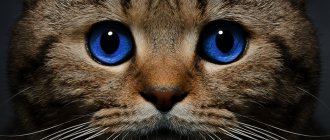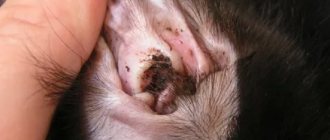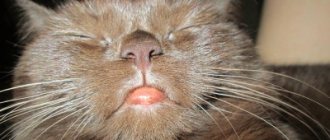Cats are partial to indoor flowers in pots. Not only do they strive to dig up their roots, but they also try to taste the stems and leaves. This can be a problem both for the flower itself and for the cat. Some indoor plants are so toxic and poisonous to cats that they can lead to poisoning, allergies, illnesses and even a sad outcome.
However, outdoor plants are no less dangerous for cats. Some are useful to chew in order to cleanse the body of hair and replenish the deficiency of minerals and vitamins, while others are very harmful to the pet’s health.
We will tell you about all the dangers that outdoor and indoor plants pose to pets. We'll give you some advice on how to wean your cat off the bad habit of tasting plants. We will tell you what to do if your animal has eaten something harmful and poisonous.
Houseplants that are dangerous for cats
Indoor plants that need to be placed out of reach of cats or get rid of them.
Azalea . Causes dyspeptic disorders. May lead to the death of the animal.
Aloe vera . The sap of the plant is toxic; it contains toxic substances - saponins. In case of poisoning, diarrhea, vomiting, lethargy, depression, impaired coordination of movement and convulsions appear.
Amaryllis . The flowers of the plant are the most poisonous. Flower poisoning causes vomiting, convulsions, depression, and increased salivation.
Anthurium . Poisonous flower. Causes swelling of the oral mucosa.
English ivy . Causes dyspeptic disorders, burning sensation on mucous membranes.
Asparagus . Causes vomiting and diarrhea.
Begonia . Contains oxalic acid. All parts of the plant are dangerous. Causes swelling of the larynx and burns of the oral mucosa.
Gardenia jasmine . Allergic dermatitis is possible.
Geranium . The common plant is considered beneficial to humans, but poses a danger to cats. Contains toxic substances: linalool and geraniol. In case of poisoning, skin rashes, loss of appetite and depression are possible. The blood-red plant is especially dangerous.
Hydrangea . Contains cyanide, which causes severe intoxication to the animal's body.
Decembrist . Causes swelling of the larynx. The entire plant is poisonous. The leaves are the most dangerous.
Dieffenbachia . If it comes into contact with mucous membranes, it causes severe burns. Causes excessive salivation, vomiting, difficulty breathing
Kalanchoe . An extremely popular houseplant, it is extremely dangerous for pets.
Ivy . Causes pulmonary, renal and heart failure.
Spathiphyllum . Burns mucous membranes.
Usambara violet . A common indoor flowering plant causes vomiting and gastrointestinal upset in cats.
Philodendron (Swiss cheese) . Possible burns to the larynx and tongue. Causes vomiting, diarrhea, abdominal pain, cramps.
Ficus . Possible burns to the oral mucosa. Digestive disorder.
Chlorophytum . Cats prone to allergies may develop allergic dermatitis.
Cyclamen . It is especially dangerous during the period of its active flowering.
Schefflera . Causes irritation of mucous membranes, dermatitis is possible.
Pike tail (Sansevieria) . Contact dermatitis is possible.
Euphorbia (euphorbia) . A milky sap containing euphorbine (poison) is secreted. Causes conjunctivitis, burns, and irritation of mucous membranes. May cause nervous disorders and cause blindness.
Be vigilant if the following grow in your house: hyacinth, calla lilies, sprenger fern, primrose, croton, dracaena, monstera.
Diagnostic methods
It is not recommended to self-medicate; the cat needs enhanced clinical therapy, which is only possible in a veterinary clinic. If possible, the owners collect the remains of the animal’s vomit and feces in separate containers for analysis. To determine the extent of damage to the kidney and liver tissue, the doctor prescribes the following studies:
- general urine and blood tests;
- examination of vomit (if provided);
- blood biochemistry;
- ultrasound examination of internal organs.
Return to contents
Poisonous garden plants
Dangerous plants that await cats in garden beds and garden beds:
Tulips and hyacinths . The most toxic to animals are the bulbs of these plants. The alkaloids contained in them cause poisoning, which is accompanied by salivation, vomiting, and diarrhea. Therefore, you definitely need to know how to treat diarrhea.
Oleander . A beautiful shrub with evergreen leaves and delicate flowers. Causes vomiting, diarrhea, slows heart rate.
Crocuses . Plants that cause vomiting, diarrhea, gastrointestinal bleeding, kidney and heart problems.
White acacia . Poisoning by acacia leaves is manifested by vomiting, diarrhea, convulsive spasms, and abdominal pain. Possible disturbances in the functioning of the heart, liver and kidneys.
Calendula (marigold) . Vomiting may occur if parts of the plant are eaten.
Daisies . A plant with low toxicity. If large amounts are eaten, loss of appetite, vomiting and diarrhea may occur.
Iris . Causes vomiting, diarrhea, stomach cramps, depression.
Clematis . Poisoning is manifested by gastrointestinal disorders: diarrhea, vomiting, refusal to eat.
Rhubarb . The leaves of the plant contain oxalates. Has a systemic toxic effect.
Garden rhododendron (rose tree) . Possible heart rhythm disturbances. Intoxication of the body.
Evergreen boxwood (buxus) . The decorative evergreen shrub causes severe intoxication in cats. Possible death.
Physalis . Causes convulsions and gastrointestinal upset.
Pansy (viola).
Also poisonous in garden plots are:
- hawthorn;
- wisteria;
- ivy;
- barberry;
- oregano;
- poppy;
- tobacco;
- dogwood.
Important!
Even if your cat is never outside, she may encounter a dangerous garden flower in the bouquets and flower arrangements you bring home.
Rehabilitation process
After providing pediatric assistance and carrying out the necessary procedures, owners are usually allowed to take the poisoned pet home.
The only exceptions to this rule are extremely severe cases of intoxication, when the animal must constantly be under IV drips or dialysis. Then he will be kept in a hospital until his general condition stabilizes.
In any case, after bringing the sufferer home, cat owners need to follow all the doctor’s recommendations, including how, what and how many times a day to feed, what medications to give, and how often to go to the clinic to monitor the pet’s condition.
In the event that IVs were prescribed, but the cat was not left in the hospital, the owners will have to take him to the clinic for procedures at the appointed time. Violation of this regime is completely unacceptable, since at the slightest deviation from following the doctor’s recommendations, the cat may develop severe complications caused by damage to the kidney tissue.
Lily poisoning is considered very dangerous for cats, but the likelihood of developing serious complications depends to a large extent on the individual characteristics of the animal. Some cats are more susceptible to lily toxins, others less so. Some of the purrs recover after minimal therapy and do not experience any consequences of poisoning in the future.
Poisonous flowers from bouquets
When bringing a beautiful flower arrangement into your home, remember that not all flowers in bouquets are safe for cats.
Hyacinths . Contain alkaloids. Symptoms of poisoning: convulsions, gastrointestinal upset.
Gladioli . Eating the leaves of the plant may cause diarrhea, vomiting and bleeding.
Calla lilies . Contains calcium oxalate and other strong allergens. Symptoms of poisoning: swelling of the mouth, nausea, excessive salivation.
Lilies of the valley . This plant contains cardiac glycosides, which have a strong effect on the heart. Poisoning with these substances causes vomiting, diarrhea, cardiac arrhythmias and a decrease in heart rate.
Lilies . Very toxic plants. Even lily pollen is dangerous for cats. Cause serious poisoning, kidney failure, allergies.
Daffodils . Both the bulbs and the stem with the flower are dangerous, as they contain a substance that causes severe vomiting, abdominal pain, and can lead to disruption of the heart and breathing.
Lilac . Some species are toxic to cats. Symptoms of poisoning: loss of appetite, vomiting, weakened renal function.
Chrysanthemums . Popular but toxic flowers for cats. In case of poisoning, vomiting, diarrhea, and loss of coordination of movement are possible.
Important!
Don't let cats drink water from the vase! In flower shops, special preparations are added to water for flowers - they are toxic to cats.
Memo to the owner
Observant owners have noticed that cats also have an irresistible curiosity about new plants brought into the house. They love to smell them, play with them, touch them with their paws, or, most dangerously, taste them. They also recorded a love for citrus fruits, although they hate their aroma. Therefore, when purchasing flowers and herbs, it is advisable to obtain information about each plant to ensure their safety for pets. Here you already have to choose what you love most: flowers or cats. It is best to learn the properties of all plants than to deal with the consequences.
In addition to playing, cats eat suitable flowers to increase the amount of minerals and vitamins. While eating useful plants, cats may stumble upon dangerous ones. Therefore, in order to protect the lives of cats, it is necessary to create an atmosphere of calm and security. And to do this, you need to destroy those herbs in the garden and in the house that can lead to poisoning or death of the animal. It is also important to remember that fertilized soil or soil treated with beetles near plants can have a negative effect on them.
Wild plants and herbs that are dangerous for cats
At the dacha or in the courtyard of a country house, a cat can encounter many plants that are toxic and poisonous to it.
St. John's wort . Affects the cat's nervous system.
Horse chestnut . Seedlings, seeds and nuts are poisonous. Causes gastrointestinal upset, liver and kidney dysfunction.
Buttercup . Has a systemic toxic effect.
Dandelion . The poisonous sap of old plants causes burns to the mucous membranes.
Shepherd's purse . In case of poisoning, vomiting and diarrhea are possible.
Tansy . The perennial plant with a strong odor is poisonous to many animals. The inflorescences and leaves contain potent essential oils and alkaloids. Signs of poisoning: impaired motor activity and coordination of movement. Decreased appetite, depression, blurred vision. Death can occur within 24 hours.
Meadow lumbago . The sap of the plant causes skin diseases.
Celandine . Contains alkaloids, causes hallucinations, convulsions, increased salivation.
Treatment
If a cat is poisoned by lilies, it is recommended to treat it in a hospital setting.
The fact is that damage to the kidney tissue develops with lightning speed during this intoxication, and only timely therapeutic measures, such as intravenous infusions of electrolytes and plasma substitutes aimed at restoring blood flow in the kidneys and glomerular filtration, can save the cat.
In the case of lily poisoning, when treatment was not started in a timely manner, there is a very high probability that the animal’s kidneys will fail within 36-72 hours.
If treatment was started on time, and acute renal failure has not yet had time to enter the anuria phase (an animal’s condition in which there is complete urination), then the pet is likely to recover and will even probably avoid the negative consequences of poisoning for its health.
Important!
In order not to miss time and start treatment on time, it is necessary to take the pet to the clinic as soon as the owner or one of his family members sees that the cat is gnawing on a lily.
In the same case, if for some reason this cannot be done immediately, it is necessary to immediately begin providing first aid to the animal, which consists of the following:
- Immediately rinse the cat's stomach. To do this, you can pour 15-20 ml of water into her mouth through a syringe without a needle, then press on the root of her tongue to induce vomiting.
- Give your pet sorbent. If there are no veterinary sorbents at home, then you can simply give the cat half a tablet of activated carbon diluted in 5 ml of water. This solution needs to be put into the cat's mouth through a syringe without a needle.
- Give the animal something to drink. If it does not drink on its own, then you need to pour 5 ml of water into its mouth every 15 minutes; this is also most conveniently done from a syringe with the needle removed from it.
- At the first opportunity, it is necessary to take the cat to the veterinarian for examination, even if, at first glance, his condition has already stabilized.
Important!
Under no circumstances should you feed the animal until the doctor allows you to do so and prescribes it for the cat.
Preventive measures and first aid
The most effective method of prevention is to make sure that your cat cannot encounter a dangerous plant. Give up poisonous house flowers, choose safe crops for your garden plot, weed the lawn, and carefully select flowers for bouquets and flower arrangements.
If this is not possible, place dangerous plants in rooms where the cat does not go, hang them on the walls and place them higher. Try to discourage your cat from having an unhealthy interest in plants - our tips will tell you how to do this:
What can I do to stop my cat from chewing flowers?
By following simple recommendations, you can try to overcome the harmful attraction to plants:
- Place citrus peels near the flower pot or add a drop of citrus oil.
- Double-sided tape is a great way to distract attention from your flower pots. Wrap the pots with tape, cats do not like its smell and sticky texture. In the same way you can cover the perimeter of the window sill.
- Use a special repellent spray to help wean your cat off this bad habit. Repellent sprays are sold in pet stores and veterinary pharmacies.
- Do not use treats to distract the cat’s attention from the flower - the animal may develop a reflex: “I climb to the flower and get a treat.” Scold the cat in a stern voice, but do not hit him. You can clap your hands loudly or spray a little water in the direction of the cat from a spray bottle so that a negative reflex is formed: “If I touch a flower, they will scold me and it will become damp.”
- Buy oat seeds or already sprouted grass from a pet store. Firstly, it is a great substitute for attractive plants, and secondly, it is very beneficial for your pet’s health.
- Follow the advice on cat nutrition.
- Don't let your animal get bored, buy him toys, play labyrinths and tunnels.
Diagnostics
You should not make diagnoses yourself, as the likelihood of error is quite high. Even if the owner saw that his pet was gnawing on lilies, the diagnosis still needs to be entrusted to a specialist.
Therefore, it is recommended that at the first signs of poisoning, take your pet to a veterinary clinic so that specialists can conduct a series of tests based on which they can give him the correct diagnosis.
What kind of research, besides a general examination of the animal, may be needed if a cat is suspected of being poisoned by lily toxins?
- General blood analysis.
- General urine analysis.
- Biochemistry of blood.
- Ultrasound of internal organs.
Before making a correct diagnosis, you should under no circumstances begin to treat your pet on your own. In the same case, if a trip to the clinic is temporarily impossible for one reason or another, it is permissible to provide first aid to the cat without resorting to the use of medications other than sorbents, such as activated carbon.











